Lebanon beyond Beirut, Byblos and Baalbek
This was my fourth trip to Lebanon. I often get asked why I keep visiting Lebanon. Despite being a small country, Lebanon is one of the most culturally diverse countries in the region.
My previous trips to Lebanon were focused more on exploring Beirut and Lebanon’s historical sites, such as Byblos, Baalbek, Tripoli and Sidon. This time around, I decided to take a break from Beirut and spend more time in the mountains as I wanted to explore the nature reserves and villages. After my amazing stay at Salvadonica, an agri-tourism stay in Tuscany earlier this summer, I was inspired to stay at similar authentic places in Lebanon, tucked in lush green surroundings and where I could enjoy good food made from locally sourced ingredients.
For those of you who don’t know, Lebanon is the greenest country in the Middle East and also home to Kamouaa forest, the largest forest in the Middle East . Giant cedars, pines, firs and oaks define the flora of the mountains (No, you won’t find any dunes or camels here!). Lebanon also has six ski resorts, which attract many visitors in the winter.
Why do I keep going back?? For some reason, I feel at home when I am in Lebanon. I feel recharged after visiting. In addition to its rich history, picturesque mountain villages and lush green mountains, I like two things in particular about Lebanon. First, is the people! Lebanese people are amongst the most hospitable and warm people I have ever come across. I love their spirit and energy. They live life to the fullest. Their energy is almost infectious. Secondly, and most importantly, I love the food in Lebanon. In addition to Italy, I feel Lebanon has the best food in the world. Thanks to a favourable Mediterranean climate, the quality of vegetables and herbs is excellent!
In this article, I will be covering my stays at boutique guest houses in Mount Lebanon, my trips to the nature reserves of Horsh Ehden, Ehmej and Tannourine and mountain villages I explored.
Country Highlights
- Lebanon is a tiny country located with Mediterranean Sea to the west, bordering Syria to the north and east and Israel in the south
- Population: 6 million
- Capital: Beirut
- Language: Arabic
- Currency: Lebanese Pound
- Gained independence from France in 1943
- Demographics: Lebanon has a total of 18 religious sects, with Christians making ~ 40% of the population, Muslims ~ 54% and Druze ~ 6%.
- Politics: Lebanon is the only parliamentary democracy in the world to follow a Confessional system, where the “President” must be a Maronite Christian, the “Prime Minister” must be a Sunni Muslim and the “Speaker of the House” must be a Shia Muslim.
Visa
Please check the requirements for your country on the Lebanese Embassy website. The majority of the EU nationals, including those from the UK, do not need a visa in advance to visit Lebanon. The immigration process on arrival is fairly straightforward and quick. The immigration official will simply stamp your passport on arrival. You will, however, be denied entry if you have been to Israel previously before or carry an Israeli visa or immigration stamp in your passport or travel document.
Currency
The currency of Lebanon is Lebanese Pounds (1 GBP ~ 2,000 LBP and 1 USD ~ 1,500 LBP). USD are readily accepted by majority of the cafes, restaurants, taxi drivers and tour operators.
Is Lebanon safe to visit?
Yes, yes, and yes! Despite being located in one of the most turbulent regions of the world, Lebanon is one of the safest countries in the Middle East and has one of the lowest rates of violent crime in the world. Lebanon went through a deadly civil war, from 1975 to 1990, but has been generally stable and peaceful since the end of the war (with the exception of a month long war with Israel in 2006).
In Lebanon, you will find several military checkpoints along the highways that have been put in place to strengthen the security and safety of Lebanon’s borders, given the geopolitics of the region and the history of interference from neighbouring countries. Never have I at any point felt unsafe in Lebanon. Tourist scams and petty crimes, such as pickpocketing and mugging, which are often experienced by travellers in European cities such as Paris or Barcelona, are almost non-existent in Lebanon.
Transport
The only negative I see in Lebanon is its limited public transport system. There are buses which connect the main coastal cities like Beirut, Byblos, Tripoli etc (unfortunately there are no trains in Lebanon). If you want to visit the mountains, you either need to hire a car, join an organised tour or hire a taxi. I would recommend hiring Ali Dbouk, who is an experienced driver and knows Lebanon inside out. Ali is professional, punctual and respectful. He has a clean and comfortable Mercedes E class. Contact him on +966 70 200 911 to book your airport transfers & other day tours.
Suggested 5 day itinerary
Day 1: Mejdel Aaqoura
I was keen to explore the mountains, nature reserves and mountain villages in Lebanon this time. I stumbled upon “Guita’s Bed & Bloom”, an agri-tourism stay in Mejdel, Mount Lebanon, when researching family-run farm stays. It took less than 90 minutes for me to get to the guest house from Beirut’s Raffiq Harriri International Airport.
I was greeted by Guita on arrival, an elegant lady in her late sixtees: “Hello! You must be Addy? Welcome to our guest house.” From the moment I stepped in, I was made to feel at home. The entrance of the guest house has a very Tuscan feel to it with a vineyard at the entrance courtyard, stone house with a blue door. The guest house has 5 bedrooms, and a beautiful garden overlooking the village of Aaqoura and the green valleys surrounding it. The garden has grape vines, persimmon trees, walnut trees and pine trees. There is a swing in the garden along with hammocks and bean bags to relax, read a book or just unwind. The living room has old family pictures in black and white, which further add character to her guest house. There are travel books in the living room if you want to know more about the hikes and things to do in the area. Guita and her family own farms near Mejdel, where they have fruit orchards (apples, cherries, walnuts) and vegetables. Given it was harvesting season, I also saw the mechanical process that crushes the apples and squeezes to make juice. I have to say the best apple juice I have had was at Guita’s house. It tasted so fresh!
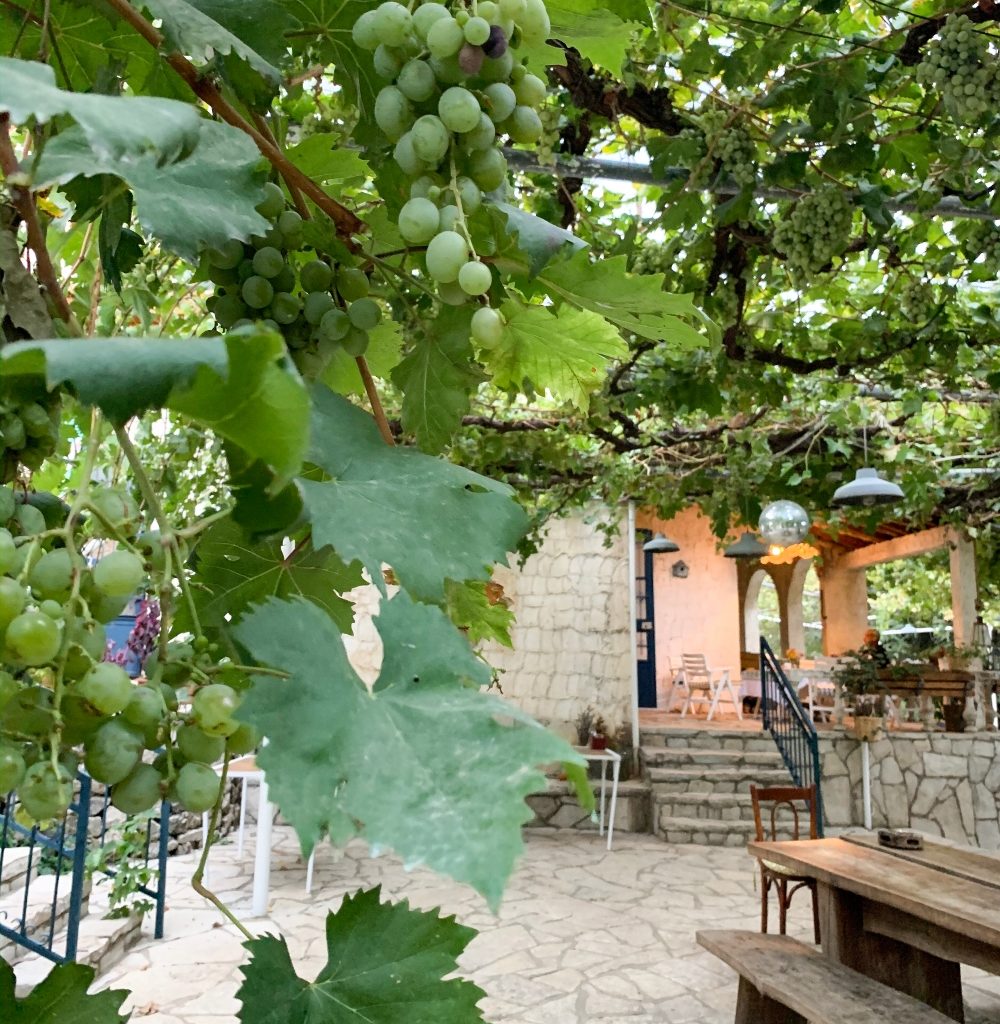
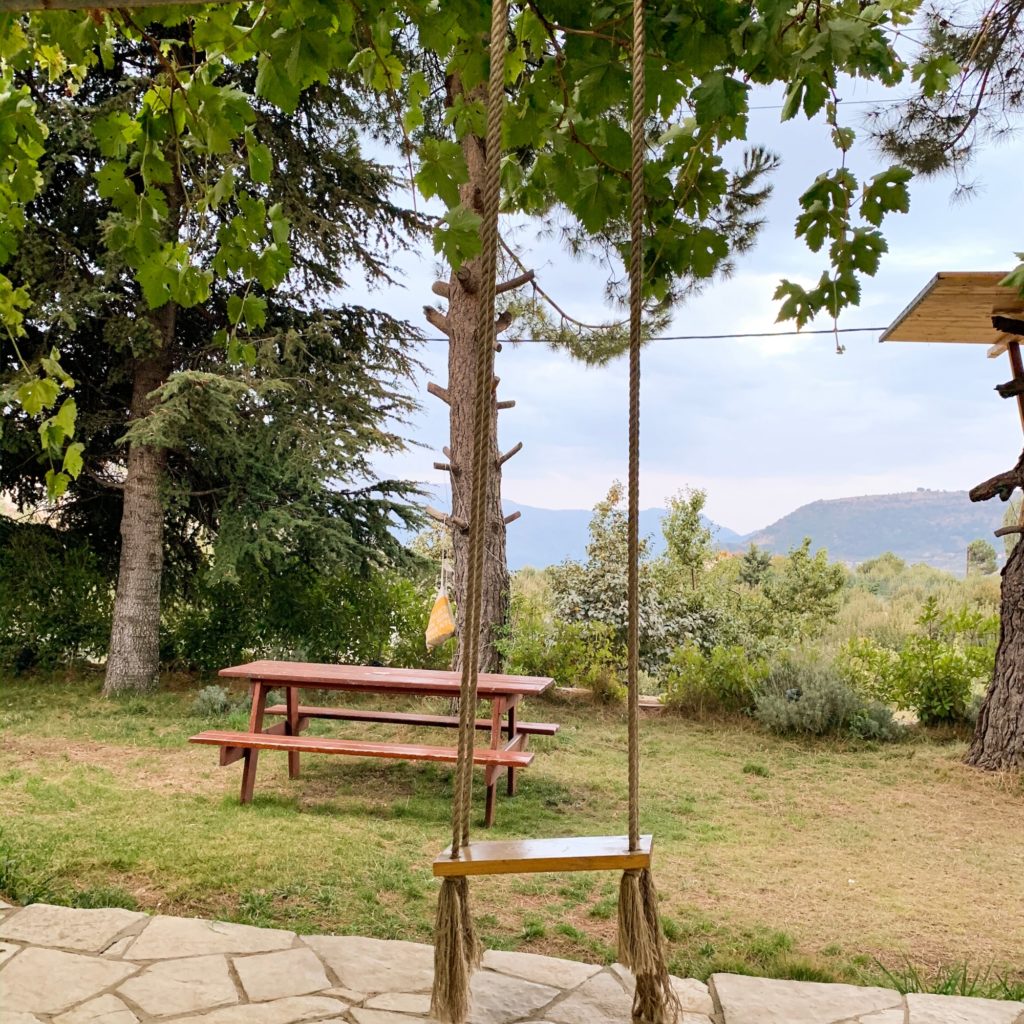

After a sumptuous breakfast and a good rest, Guita kindly offered to give me a tour of the local area, including the village of Aaqoura, which is around 45 minute walk away from the guest house. Guita showed me her family’s 100 year old ancestral house built in the Ottoman style. Guita is like a celebrity in the area. Almost everyone knows her and would stop by to have a conversation. We passed by beautiful apple orchards which had perfectly ripe red apples ready to be eaten. One of the orchard owners kindly offered us apples, which not only looked good but were crunchy, juicy and delicious.
We also visited her friend Maria’s house, which is over 150 years old. Maria has a traditional mountain house with a ceiling made of wooden logs, and arches in the courtyard. On the way back to the guest house, we also stopped by the local convent where we met the nuns who happen to be close friends of Guita.


Day 2: Horsh Ehden and Bsharri
Horsh Ehden
If you are a nature lover like me, Horsh Ehden needs to be part of your itinerary while visiting Mount Lebanon. It is one of the most beautiful nature reserves in Lebanon with well-organised and defined walking trails from which you can view the cedar, fir, pine, Syrian maple trees and a diverse variety of shrubs.
Location: Horsh Ehden is located next to the town Ehden (less than 2 hours from Beirut).
Entrance: Single ticket costs LBP 5,000 (~ USD 5).
Walking trails: There are several levels of hikes available, with 9 trails in total, all of which are clearly marked. If you do, however, want to organise a guide, you can arrange one by contacting to reserve in advance (Email info@horshehden.org or call them on + 961 70 601 601). The reception desk is pretty helpful and can provide guidance on the best trails, depending on how long you want to walk for!
Easy: If you are looking for a short easy trail to get an overall feel of the reserve, you can do Trail 2, which takes less than an hour.
Moderate: If you are looking for moderate intensity, I would recommend starting off with Trail 1 followed by Trail 3 and then Trail 2, which takes less than 2 hours. This is the trail I did as well.
The first 25 minutes of the trail were somewhat steep but once you reach the top, you are in awe of the view of the mountains covered with tall and magnificent cedar trees.
The cedar tree is the national tree of Lebanon and appears on the national flag of Lebanon. The cedar tree on the flag symbolises holiness, eternity and peace, and is referenced several times in the Bible. As it happened to be autumn, the reserve looked even prettier with a mix of red, orange, yellow and green. It was so refreshing to be in the middle of nature. I was reminded of home as I saw spotted quite a few robins flying from one shrub to the other. I never realised that the European Robin is found in Lebanon as well. I found Trail 3 to be the most exciting with narrow woodland walks in the middle of pine trees. It was fun picking up red maple leaves and pine cones as I walked along the trail.



Restaurant: After your hike, you should definitely have lunch at the restaurant “Chez Gilbert” by the entrance. I was initially hesitant to have lunch there as I am generally sceptical of cafes and restaurants located in tourist spots but my decision to eat there turned out be a good one. I had zaatar-manakeesh with labneh as my starter and the lamb awarma with scrambled eggs for my mains, both which were delicious! For those of you who don’t know, manakeesh is a flatbread made with dough and topped with olive oil and zaatar. Zaatar is a condiment made with dried thyme, oregano, marjoram mixed with sesame seeds, salt and other spices, including sumac. It is best served with labneh (strained yoghurt).
It was the first time I had tried both the dishes, which now count amongst my favourites along with chicken fateh.
Bsharri
I decided to stop by Bsharri, a quaint town in the mountains of North Lebanon. Bsharri is located at an altitude of over 1,500m, overlooking Qadisha valley. It’s also the birthplace of the famous Lebanese-American writer and poet, Kahlil Gibran. I visited the house of Kahlil Gibran, now a museum. I also took a stroll around the village to get a feel of the daily life here and to appreciate the local architecture, most of which retains the Ottoman style.

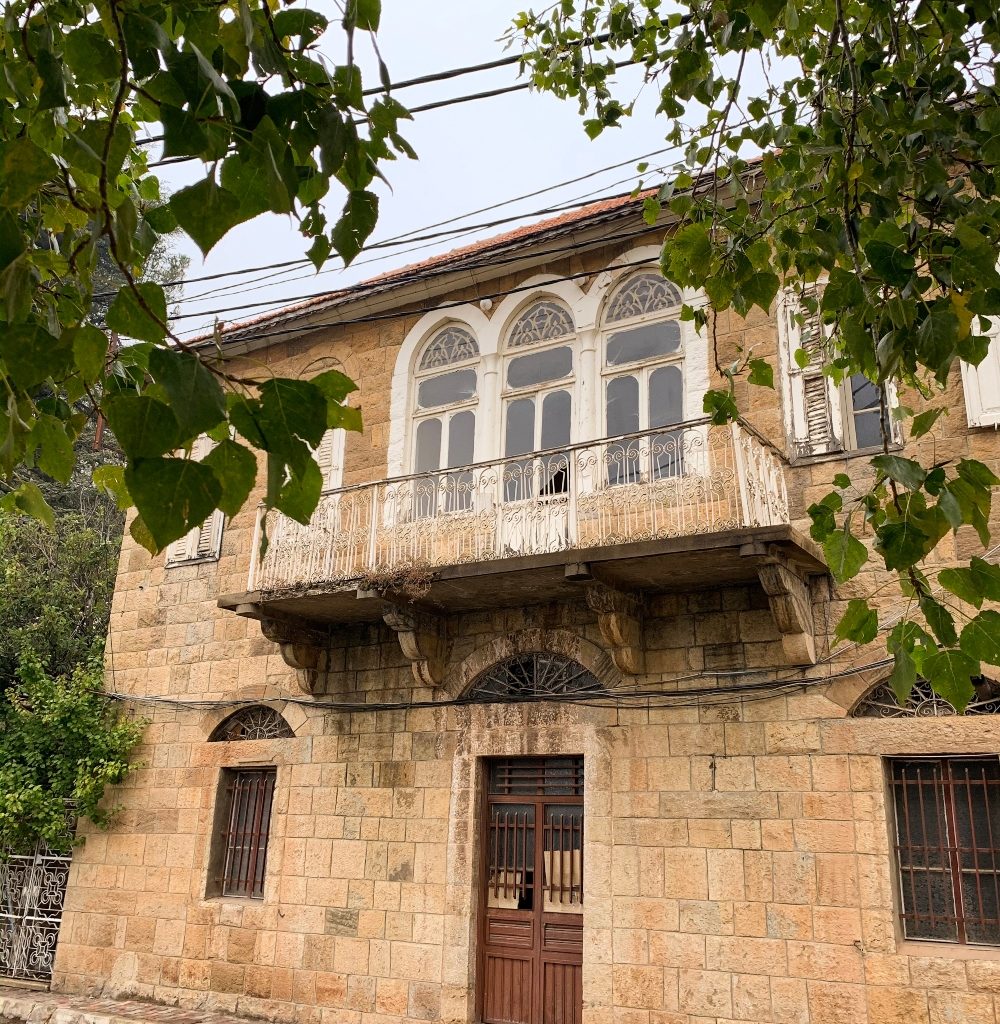
Day 3: Ehmej
Ehmej was one of the highlights of my trip. This is the place to see Mount Lebanon dressed in fall colours at its best. Ehmej is a medium intensity hike – I did 7.5 km with an overall ascent of 500m which took around 3.5 hours. Ehmej does not have any marked walking trails, unlike Horsh Ehden or Tannourine, so my hiking guide Mohammad came in very useful. There are tall, magnificent pines, oak trees and maple trees in the reserve. There are a few cliffs in the reserve from which you can really appreciate the beauty of the surrounding mountains. I was lucky to be there in autumn when the shades of red, yellow, orange and green made the mountains looked even prettier. While hiking, we passed by an apple orchard with ripe red and golden apples. The orchard staff kindly allowed us to pluck the apples we wanted, which, I have to say, were delicious.



Recommended tour: I would recommend hiring Mohammad El-Drahi, who is an experienced hiking guide and very familiar with the best hiking trails in Lebanon. He can be contacted on + 961 70 360 030 via Whatsapp if you wish to enquire further about Ehmej or other hiking trails in Lebanon.
Day 4: Tannourine and Douma
Tannourine Cedar reserve
Visiting a cedar reserve was one of my “to do” list items in Lebanon. Tannourine Cedar Reserve is the largest and most dense cedar reserve in Lebanon. It is an enchanting place with well-organised hiking trails. After having visited the reserve, I understand why the cedar tree appears on the Lebanese flag – they are truly majestic. There are also quite a few cliffs from which you have beautiful views of the mountains and cedar trees.
Entrance: 5,000 LBP

Monastery of Houb
The monastery of Houb is situated on a picturesque hill in the village of Wata Houb, overlooking Tannourine in the Batroun district in north Lebanon (approximately 55 miles from Beirut). Established in the 18th century, the monastery is dedicated to St. Anthony the Great of Houb. The monastery is built in stone with a red tiled roof, which is typical of the architecture in the Lebanese mountains. The interior patio comprises of arches, with a garden surrounded by grape vines and cedar trees.
Entrance: Free


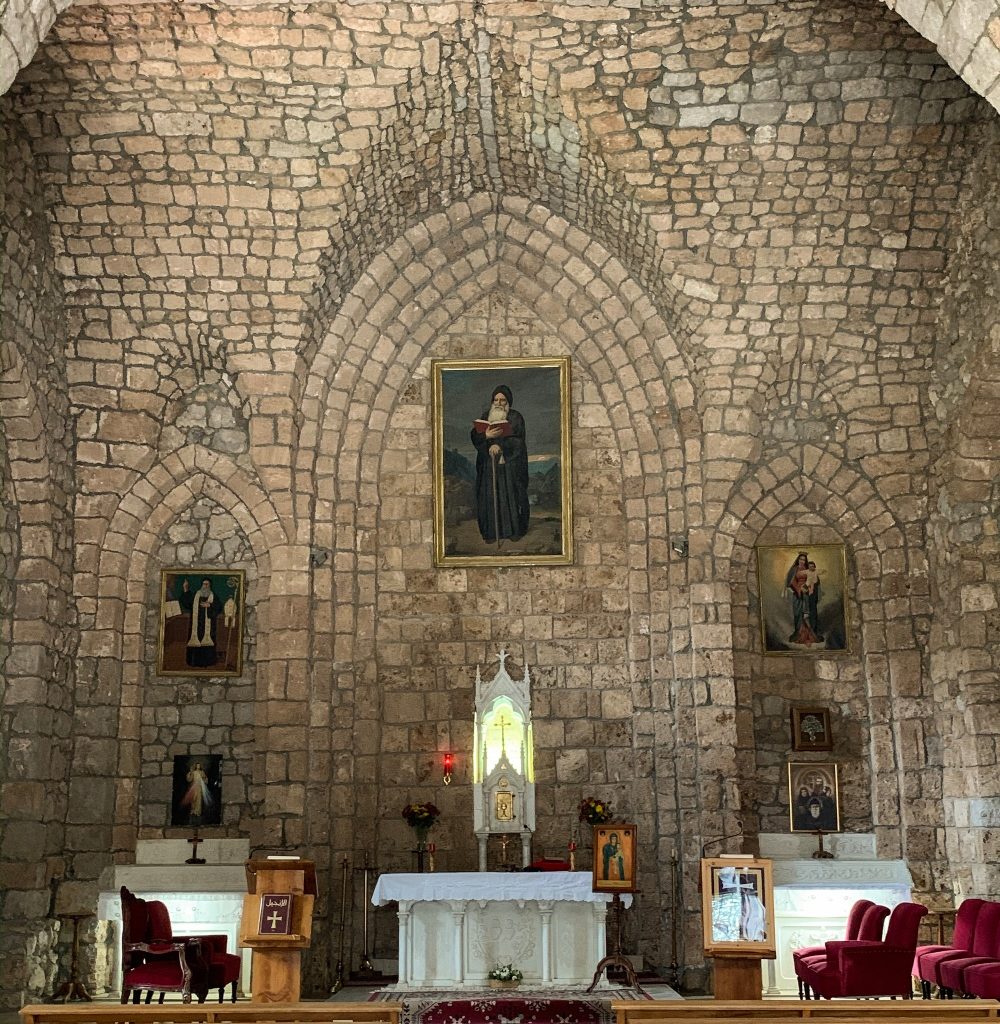
Tannourine village
Take a walk around the quaint historical village of Taanourine. Tannourine is a charming mountain village with stone brick houses with red roofs built in the Ottoman style and a big church in the centre. The best way to explore a village is to walk aimlessly and explore the alleys and neighbourhoods of the village. If you do meet people, greet them by saying “Merhaba” (Hello) or “Keef Haq” (How are you?). People in Lebanon, especially in the mountains, are extremely friendly and hospitable.


Baatara sinkhole
The Baatara waterfall is a natural waterfall located in Tannourine, near Balaa village, with 3 natural bridges. The waterfall drops over 250 meters into a limescale cave dating back to the Jurassic period (around 160 million years old). It’s a very unique waterfall, different from anything you might have seen before.

Douma
If you want to see an authentic Ottoman village, you need to visit Douma in Lebanon. All the houses in Douma are made of stone with red tiled pyramid roofs. It has a small souk as well where you will find shops and cafes selling locally made products like jams, soaps, halwa and olive oil.

Day 5: My Stay at Beit Trad
Visiting a traditional Lebanese house
I was keen to see the interiors of a traditional Lebanese house. I managed to get in touch with Elie, a local resident of Douma who lives in a 100 year old house. Elie works for a startup firm in Beirut as a multimedia expert and runs the Instagram pages “Doumavillage” and “samirsawayapeintre“. He kindly agreed to show me his house. It’s a traditional Lebanese house made of stone with a red tiled roof. I also learnt that the house is built over big stone arches. Like any other old house, Elie’s living room has high ceilings with three arched windows and bedrooms on both sides of the living room. There are beautiful paintings, in watercolours and ink, painted by Elie’s father, the late Samir Sawaya. The ceilings of many rooms are painted with flowers and natural elements.
The house has been tastefully decorated with vintage furniture, an old vinyl player, black and white family pictures, old beds, an 80s television set and a beautiful Egyptian table made of copper that I loved. Elie said that he wants to convert it into an art gallery as a tribute to his father at some point: “I now mostly stay in Beirut because of work but I like to spend my weekends here to recharge myself and get away from the hustle and bustle of Beirut.” He then kindly offered to give me a tour of the village.



Exploring the village
We walked through the village where we saw beautiful Ottoman houses and old churches. “We have 17 churches in the village here”, Elie said, which I thought was quite a high number for a village with a population of 5,000. They have so many churches partly because of the fact that there are Maronites, Catholics and Orthodox Christians who have built their own.

The souk, in particular, was fascinating with quaint shops selling jams, halwa, soaps, olive oil and local handicrafts.

We passed by a group of elderly village men who were playing cards inside a cafe. I like photographing people, especially where I want to capture essence of local life while I am travelling to new places. I asked one of the elderly men whether I could take pictures of them playing cards. “Come in. Take as many pictures as you want” he replied. The gentleman was probably in his early eighties and spoke in perfect English which quite surprised me as I had not met anyone in the mountains with such English proficiency. It is very rare to find someone of his age speaking in such good English, especially in remote villages. “Are you from India?”, he asked me. He said he was a big Bollywood buff with Ashwarya Rai being his favourite actress. The gentleman worked in Kuwait for many years in the public sector and then decided to retire in Douma, the village where he grew up. He is now a pensioner here and earns rent from the building he has let out to the local police station. He asked me if I wanted to join them for a game of cards but I unfortunately had to decline as it was time for me to head back to the guest house. Meeting and interacting with locals like him and Elie really enriched my experience of Douma.

Recommended restaurant: Bent El Daya Café
The Bent El Daya café is a charming and cosy café located in the old souk. The ambience was what you expect from a quaint countryside restaurant in Lebanon. I ordered the lamb awarma with eggs and salad. I then tried the halwa crepe for dessert which I must say was delicious (halwa is a confectionary made from flour, sugar and butter). The café also sells homemade soaps and locally prepared products like halwa and jams. There were Fairuz’s songs playing in the background, which further added to the experience (Fairuz is one of the best and most renowned veteran Lebanese singers in, not only Lebanon, but the whole Arab world).


My stay at “Guita’s Bed and Bloom”
Staying at Guita’s Bed and Bloom was like staying at your aunt’s place. I felt very well looked after. Guita always tried to make sure that I was eating well and kept me company at breakfast and dinner. We had lots of interesting discussions about Lebanese politics, life during the civil war, exchanged stories about travel, our families and life in general.
I have to mention the meals I had Guita’s, which are amongst the best meals I have ever had. I got introduced to some new delicious dishes, which I had never tried before such as chicken freakah (chicken with wheat, almonds), zaatar with manakeesh, mehchi koussa (zucchni stuffed with minced lamb, tomato, rice and herbs) which were all delicious. I particularly enjoyed chicken freakah, which is apparently not served often in restaurants as it’s more of a household dish.
“We try to source the majority of the vegetables and herbs from our farm, where possible”, Guita said. Given its proximity to the Mediterranean Sea and the favourable cool temperature in the mountains, Lebanon benefits from some of the best fruits and vegetables, along with Greece and Italy. “When Philippe (Guita’s son) finished his MBA at INSEAD Paris, he came up with the idea of converting our summer guest house in Mejdel to an agri-tourism stay where guests could relax and unwind and enjoy good meals prepared from ingredients sourced from their farms. I was initially hesitant as I didn’t know how the concept of agri-tourism in Lebanon would work but in hindsight it’s the best decision he has taken. We have near full occupancy in summer with guests from all over”, Guita, his proud mother, said. Guita’s guest house serves as a perfect base to explore the mountains and villages of Mount Lebanon. In addition to Guita’s warm hospitality and delicious meals, I liked the fact that all guests get to have meals together on the dining table, which is a great way to connect with travellers while travelling in an informal way. There were guests from New Zealand and France with whom I had lovely conversations.

The best guest house: Beit Trad, Kfour
Location: Situation in Kfour, Mount Lebanon (~ 45 min from Beirut)
Beit Trad is by far the most beautiful guest house I have ever stayed in. Beit Trad is an Ottoman era house, nestled in the mountains of El Kfour, which is over 200 years old. The house is an architectural marvel with beautiful gardens retaining their original stone structure, courtyards, columns and arches. The house has nine guest rooms, so it’s pretty big! There is a long 23m swimming pool in the garden with cedar trees surrounding it, making you feel at one with nature. They have speakers all over the guest house including the gardens and pool, playing soft and relaxing music so you are soothed no matter where you are. My favourite room was the salamlik (i.e. the common room). The interiors in the salamlik have been elegantly finished with exquisite furniture, traditional carpets and skilfully carved wooden tables. There are books on travel, food and design as well as board games. You can also admire the black and white photos of Ottoman nobility. In short, a combination of fascinating Ottoman history and modern comforts in a beautiful natural setting!



I would suggest that you book the “full board” option here in order to enjoy the delicious home-cooked meals. If the weather outside is good, you can always request the staff serve your breakfast or lunch outside in the courtyard where you can enjoy beautiful views of the mountains. For breakfast, I would suggest ordering the lamb awarma (scrambled eggs with minced lamb cooked in pottery). It was so delicious! Beit Trad is the perfect getaway in Mount Lebanon to relax, unwind, and enjoy delicious meals. The reception staff can also organise guided hikes around the area on request, which is a nice bonus if you want to explore!

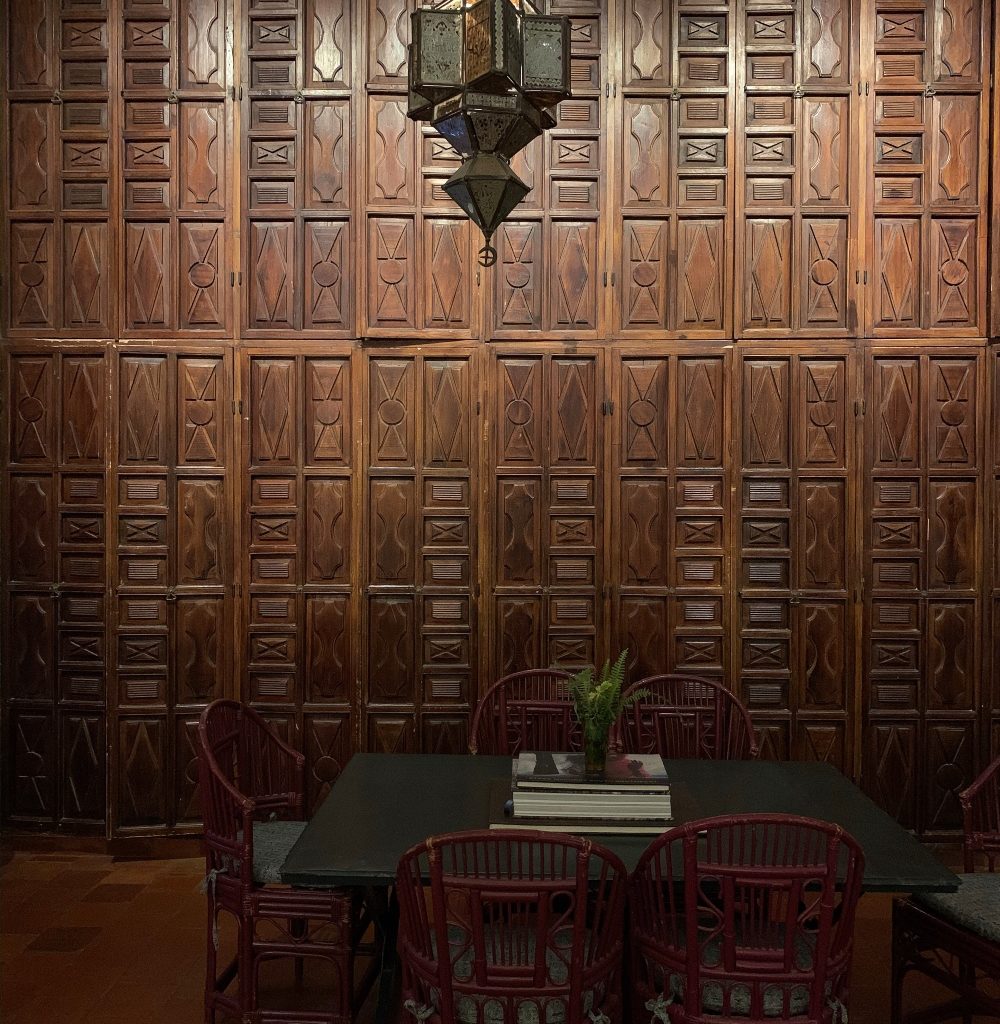

The majority of tourists end up visiting Beirut, Baalbek, Byblos and Tripoli, which are known for their rich history and vibrant souks. Having visited Lebanon four times now, I feel Lebanon a has lot more to offer than just Phoenician and Roman ruins. It hasn’t perhaps marketed its nature reserves, picturesque mountain villages and its agri-tourism stays that well. In addition to its cedar reserves, Mount Lebanon offers numerous beautiful hikes, some more strenuous than others depending on whether you’re up for some adventure! To top it up, good food always enriches one’s experience of a place and Lebanese cuisine never fails to disappoint. I am already itching to book my next flight to taste that zaatar manakeesh with labneh!




Wonderful trip with some beautiful pictures and descriptions. Lebanon sounds magical. Felt like I was actually there! Glad to know its history culture hospitality and safety.
Ameena – Thank you very much for your kind words. Lebanon is a real gem of the Mediterranean! You have to visit 🙂
Reading this makes me want to visit Lebanon and explore all of those trails in the nature reserves then eat all of the delicious food you mentioned!
Thank you so much Ariane! I highly recommend visiting Lebanon – The food is truly divine. I can’t wait to go back myself 🙂
What a seasoned traveler! Whenever I go, I shall come back to this day-to-day itinerary. Beautiful images too
Thank you very much Sahar! Yes not far for you – You will love the mountains there 🙂
Thank you Addy for this wonderful article and for your visit to my place at Douma Village. I love this article it’s rich in new places from Lebanon that i didn’t visit yet and really shows the beauty side of our country. All the luck in your futur trip we’ll be waiting for new articles
Elie, thank you for your kind words! Thank you so much once again for showing me your beautiful house and your warm hospitality. Douma is such a beautiful village – very glad to have visited it!
Thank you for sharing another wonderful article. Lebanon is indeed a beautiful country and this article is a testimony to that fact.😊
As someone who has been closely following all your trips, I always look forward to reading your blog posts. Not only are they filled with beautiful experiences, pictures and really good food recommendations but also cover important details and information which would be very helpful for people willing to visit the places you already did.
The simplicity and honesty with which you describe your experiences is just amazing! Can easily relate to them. Eagerly looking forward to your next trip now!😊
Thank you very much for your kind words – Means a lot!
Very glad to hear you enjoyed reading my articles. I love travelling and sharing my experiences. Always encouraging to read such comments 🙂
Thanks for this well written article that gives good guidance to exploring Lebanon off the beaten track. It’ll make planning a trip to the country very easy as you’ve included all the necessary details.
Mihir, Thank you very much for your kind words and glad to know you liked my article! Best wishes 🙂
Hi Aditya , a very comprehensive and a vivid coverage of Lebanon . Your article has really aroused our interest to visit this beautiful country . . Works as a great preamble for planning the trip to this divine country . God bless and keep it up . Anu aunty
Thank you very much for your kind words aunty! Glad to hear you enjoyed reading it and would consider visiting Lebanon – Hope you are well 🙂
Great article with beautiful pics! Can’t wait to visit!
Thank you very much Fatty! Yes, you must plan a trip soon 😀
I really liked this article.
I can say that Adi is doing good, on this “touristic” journalism.
The information given is short,well sorted and all a tourist needs.
👍🏻
Thanks very much for your kind words Fjodor – Glad to know that you enjoyed reading my article 😀
Such an amazing article, it seemed like reading a storybook. Beautiful pictures and excellent content, you have sold Lebanon to me – on my buck list now.
Thank you very much Aqsa – Glad you liked my article and pictures. Yes, you must visit Lebanon whenever you get a chance 🙂
Loved the content! I want to buy the old iron and the teapot in the photo!
Thank you very much Pritisha. I am glad you enjoyed reading my article 😀